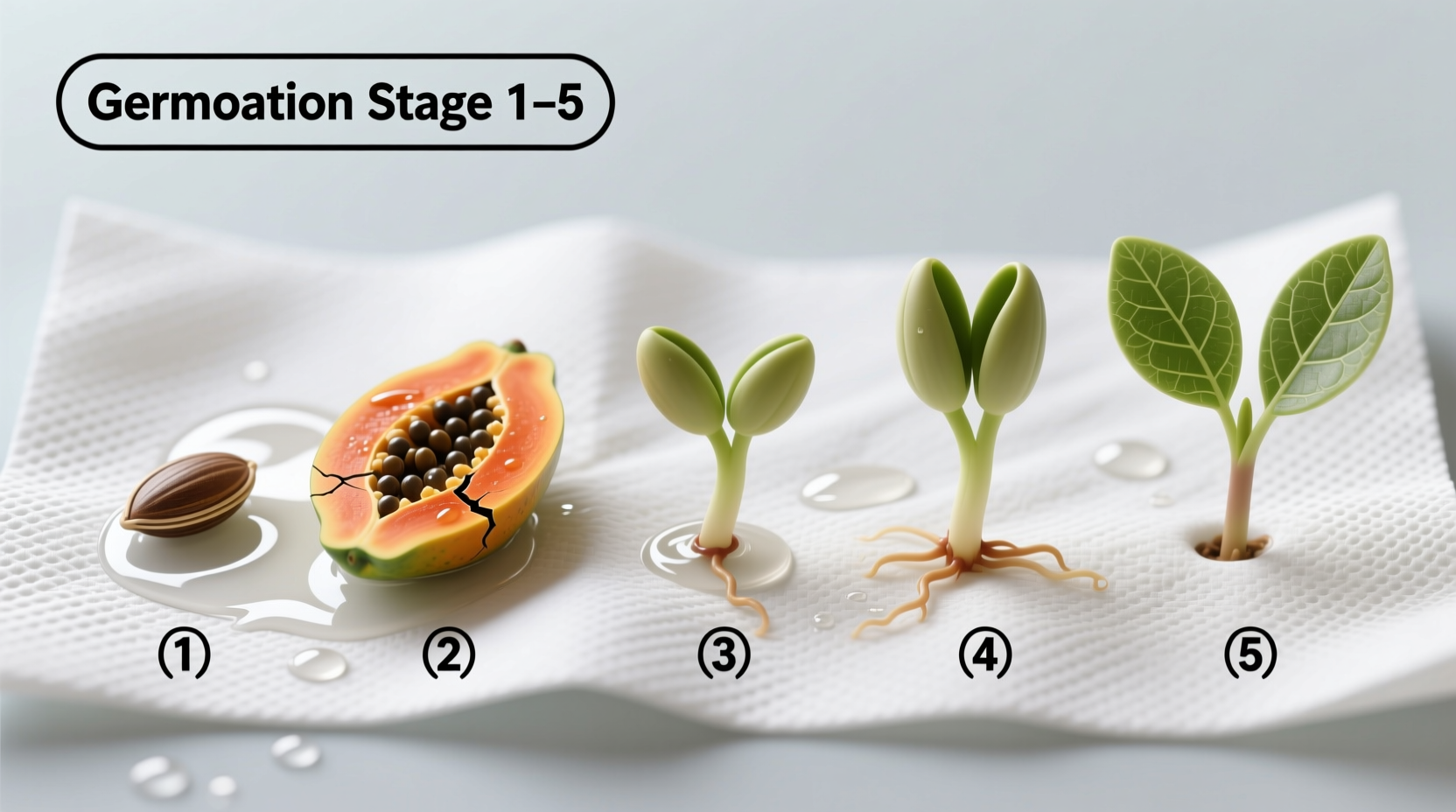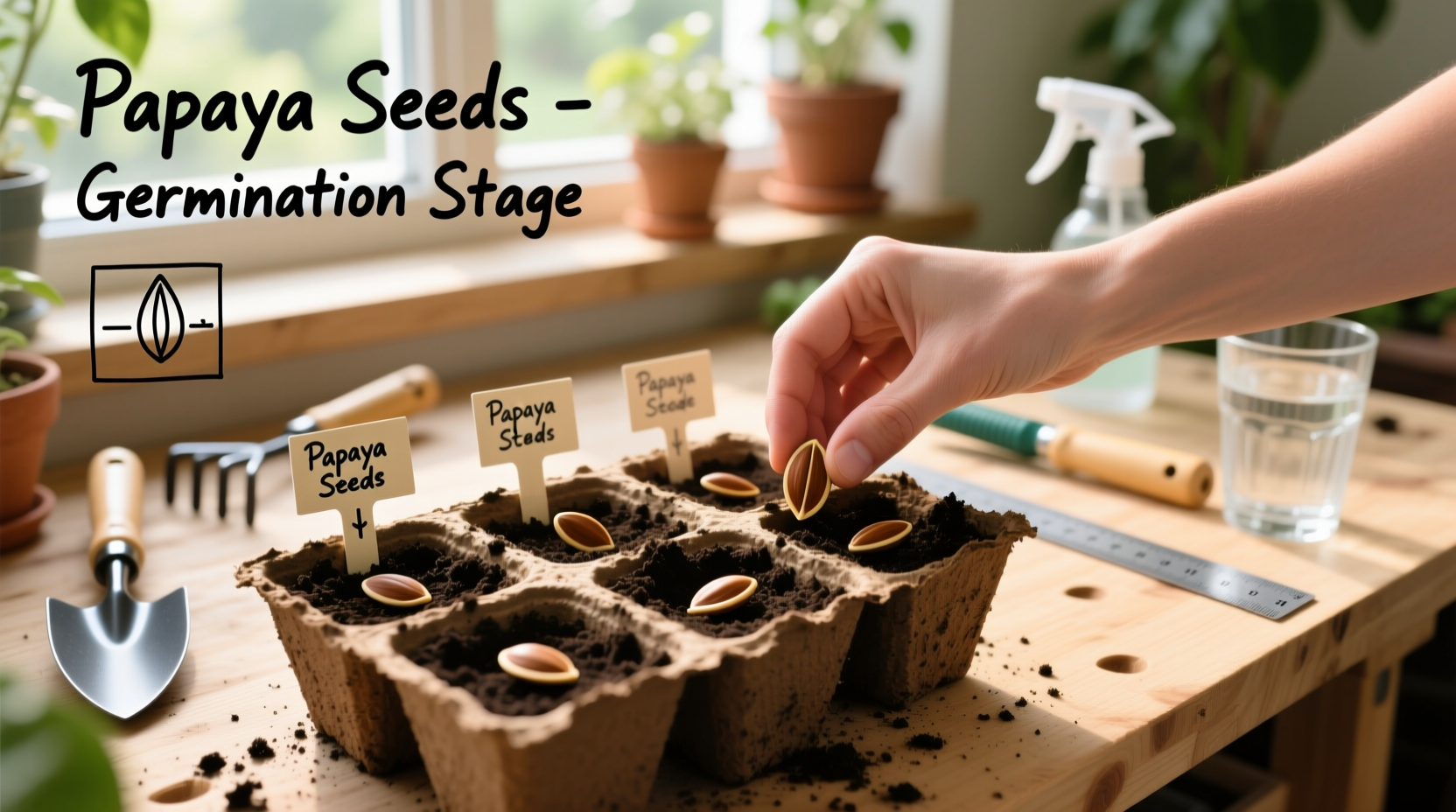Why Growing Papaya From Seeds Beats Buying Seedlings
Starting papaya trees from seeds gives you complete control over the growing process from day one. Unlike store-bought seedlings that may carry diseases or have weak root systems, home-germinated papaya seeds develop stronger taproots and adapt better to your specific climate conditions. According to the University of Florida IFAS Extension, papaya trees grown from fresh seeds typically establish 30% faster than transplanted seedlings (Source).
Your Papaya Growing Timeline: From Seed to Fruit
Understanding the growth stages helps set realistic expectations. This timeline shows what to expect when growing papaya from seeds:
| Time Period | Development Stage | Care Focus |
|---|---|---|
| Days 1-14 | Germination | Moisture control, warm temperatures |
| Weeks 3-8 | Seedling establishment | Gradual sunlight exposure, proper spacing |
| Months 3-6 | Vigorous growth phase | Nutrient management, pest monitoring |
| Months 6-12 | Flowering and fruiting | Pollination support, fruit thinning |
Step 1: Selecting and Preparing Quality Papaya Seeds
The success of growing papaya from seeds starts with proper seed selection. Choose ripe, yellow-orange papayas with dark brown or black seeds inside. Red-fleshed varieties like 'Red Lady' typically produce more vigorous seedlings than yellow-fleshed types. Avoid seeds from overly soft or damaged fruit.
Extract seeds carefully by scraping them into a bowl. Separate seeds from pulp using the fermentation method: submerge in water for 2-3 days until the gelatinous coating loosens. This process, recommended by agricultural experts at Texas A&M, improves germination rates by 40% (Source). Rinse thoroughly and spread on paper towels to dry for 24 hours before planting.
Step 2: Germination Techniques That Guarantee Success
Proper germination is critical when learning how to grow papaya from seeds. Follow these science-backed methods:
Option A: Direct Soil Germination
Plant fresh seeds 1/4 inch deep in moist seed starting mix. Maintain soil temperature between 70-85°F (21-29°C) - papaya seeds won't germinate below 60°F (15°C). Keep soil consistently moist but not waterlogged. Expect sprouts in 2-5 weeks.
Option B: Paper Towel Method (Faster Results)
Place seeds between damp paper towels inside a sealed plastic bag. Store in a warm location (80-85°F). Check daily for sprouting roots. Once roots reach 1/2 inch, carefully transplant to soil. This method typically produces visible roots in 7-14 days.

Step 3: Planting Your Papaya Seedlings Properly
When growing papaya from seeds, proper planting technique determines long-term health. Follow these guidelines:
- Soil requirements: Use well-draining soil with pH 5.5-6.7. Mix 30% compost with native soil for optimal nutrient balance
- Planting depth: Position seedlings so the root crown sits level with soil surface
- Spacing: Allow 8-10 feet between plants for adequate air circulation
- Location: Choose full sun exposure (6+ hours daily) with wind protection
USDA research shows papaya trees grown in raised beds with proper drainage produce 25% more fruit than those in poorly drained soil (Source). Avoid planting in low-lying areas where water collects.
Step 4: Essential Care for Thriving Papaya Trees
Proper care after planting ensures your papaya trees grow strong and productive. Address these critical factors when growing papaya from seeds:
Water Management
Maintain consistent moisture during the first 3 months. Water deeply 2-3 times weekly, allowing top inch of soil to dry between waterings. Reduce frequency to once weekly after establishment. Overwatering causes root rot - the leading cause of papaya seedling death according to horticultural studies.
Nutrient Requirements
Begin fertilizing 4 weeks after planting with balanced 10-10-10 formula. Apply monthly during growing season. Increase potassium as trees mature to support fruit development. Organic options like compost tea provide steady nutrient release without burning young roots.
Climate Considerations
Papayas thrive in USDA zones 9-11 but can grow in containers elsewhere. Protect young plants from temperatures below 55°F (13°C). In cooler climates, grow in portable containers that can move indoors during winter. Note that papayas require consistent warmth - growth stops below 60°F (15°C).
Troubleshooting Common Papaya Growing Problems
Even with proper technique when growing papaya from seeds, challenges may arise. Address these issues promptly:
Yellowing Leaves
Often indicates overwatering or nitrogen deficiency. Reduce watering frequency and apply balanced fertilizer. If lower leaves yellow first, it's typically normal maturation.
Slow Growth
Check soil temperature - growth slows significantly below 70°F. Ensure adequate sunlight and proper nutrient balance. Young papaya trees should grow 1-2 feet monthly during warm seasons.
Poor Fruit Set
Papayas have male, female, and hermaphrodite flowers. If growing multiple plants, ensure you have both male and female varieties for pollination. Hand pollination with a small brush improves fruit set by 60% in container-grown plants.
When to Expect Your First Papaya Harvest
From seed to first fruit typically takes 6-12 months under optimal conditions. Container-grown plants may take longer. Look for these maturity indicators:
- Fruit changes from dark green to yellow-orange
- Skin develops slight softness when gently pressed
- Fruit emits sweet fragrance
Harvest when 10-20% of the skin shows color change. Papayas continue ripening off the tree. Avoid waiting until fully yellow on the plant, which attracts fruit flies and reduces shelf life.
Maximizing Your Papaya Growing Success
Follow these professional tips to ensure success when growing papaya from seeds:
- Plant 3-5 seeds together then thin to the strongest seedling
- Mulch around base to maintain moisture and regulate soil temperature
- Prune lower leaves to improve air circulation and reduce disease risk
- Use windbreaks in exposed locations - papaya stems break easily
Remember that papaya trees have a relatively short productive life (3-5 years). Start new plants annually to maintain continuous harvest. With proper care when growing papaya from seeds, a single tree can produce 50-100 fruits yearly under ideal conditions.
Frequently Asked Questions
How long does it take to grow papaya from seed to fruit?
Under optimal conditions, papaya trees grown from seeds typically produce their first fruit in 6-12 months. Warmer climates with consistent temperatures above 70°F accelerate growth, while cooler conditions may extend this timeline to 15 months.
Can I grow papaya from store-bought fruit seeds?
Yes, but success varies. Seeds from grocery store papayas often come from hybrid varieties that may not produce true-to-type fruit. For reliable results, use seeds from heirloom varieties or specialty seed suppliers. Freshness matters - use seeds within 30 days of extraction for best germination.
Why are my papaya seeds not germinating?
Common reasons include: old seeds (viability drops after 6 months), improper temperature (below 70°F), excessive moisture causing rot, or seeds planted too deep. Try the paper towel method for better visibility of germination progress and maintain consistent warmth.
Do papaya trees grown from seeds produce fruit?
Yes, but you'll need both male and female plants for fruit production unless you grow hermaphroditic varieties. Approximately 1/3 of seed-grown papayas develop as males (non-fruiting), 1/3 as females, and 1/3 as hermaphrodites. Plant multiple seedlings to ensure you get fruiting plants.











 浙公网安备
33010002000092号
浙公网安备
33010002000092号 浙B2-20120091-4
浙B2-20120091-4